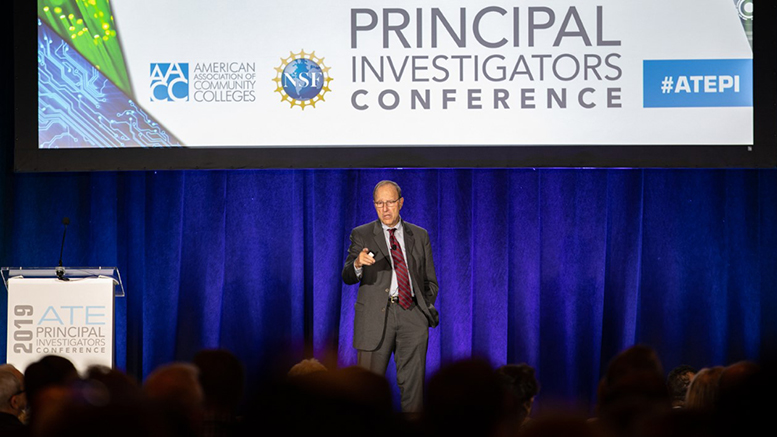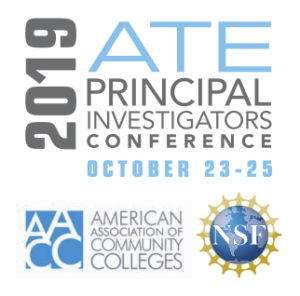
Speaking at the 2019 Advanced Technological Education Principal Investigators’ Conference, MIT professor Paul Osterman said technology will not cause “a tsunami” of job elimination, but he is worried that job quality is low for too many people. (Photo: Rachel Covello)
It was one of those moments you like to see at a conference.
On the first day of the 2019 Advanced Technological Education Principal (ATE) Investigators’ Conference, a renowned researcher called out community colleges for generally not connecting well with employers. The next day, a recently announced major college-industry partnership was featured at the meeting, providing the most recent example of ATE programs working in collaboration with industry.
In his plenary speech on Thursday, Paul Osterman, a human resources and management professor at the Massachusetts Institute of Technology (MIT), shared his research that only 20 percent of manufacturers use community colleges for employee training.
“Too many community colleges have too weak a relationship with employers,” he said.
The next day, the principal investigator of the Northeast Advanced Technological Education Center (NEATEC) at SUNY Polytechnic Institute and a leader of SEMI, the global electronics manufacturing industry association, explained the multi-level, industry-wide semiconductor technician certification they will test in three states with the support of a $6 million ATE grant from the National Science Foundation (NSF).
Fostering those connections
How to engage employers was the topic of several other sessions during the three-day ATE conference in Washington, D.C. The American Association of Community Colleges hosts the annual meeting, with NSF support, for two-year college educators and others involved in ATE initiatives to share information about their innovative technician education programs that are free for other colleges to adopt and adapt.
 NSF requires ATE grantees to work in partnership with employers and other education sectors. Consequently, the stronger connections between employers and community colleges that Osterman called for are woven throughout ATE efforts.
NSF requires ATE grantees to work in partnership with employers and other education sectors. Consequently, the stronger connections between employers and community colleges that Osterman called for are woven throughout ATE efforts.
One of the most systematic efforts to engage employers is the Business and Industry Leadership Team (BILT) model developed by the National Convergence Technology Center at Collin College in Frisco, Texas. Most of the 74 colleges in the center’s network use employers as co-leaders of their efforts. As a result of presentations about the BILT model at ATE conferences and elsewhere, the model is spreading beyond information technology programs.
Needed: more investment from business
During his speech, Osterman pointed out that “community colleges are radically underfunded” and that overall employers are investing less in on-the-job training.
“We can’t have an effective skill-training system unless employers step up their investment in training,” he said.
But Osterman, who has studied community colleges for many years, noted that “community colleges are No. 1 on his list of key players” who can address the critical issue of too many people in low-wage jobs.
“If you were going to think about how to build on or improve the skill-training system in this country, the first thing you need to turn to is the community college system,” Osterman said.
He added that he thinks momentum is growing for action on STEM workforce development, and he encouraged the ATE principal investigators to lead it.
“We actually have an opportunity to make progress on these issues because we are swimming with the current,” he told conference attendees. “You are the folks who are going to make it happen.”
Potential to grow
Community college educators are among those involved in SEMI-Certs — the multi-level, industry-wide Semiconductor Technician Certification Program that began this month when NSF awarded a $6 million grant to SUNY Polytechnic Institute and SEMI.
“We’re excited about this new paradigm that really provides a direct two-way and real-time connection between what industry needs and what community colleges can provide,” said Robert Geer, NEATEC principal investigator.
Mike Russo, vice president of Global Industry Advocacy at SEMI, calls the “talent brick wall” a bigger challenge than Moore’s law.
During his presentation at the ATE conference, Russo explained that the process for testing the competency-based model will begin at 18 technician education programs in Upstate New York that are affiliated with NEATEC. Next year, the effort will expand to the Research Triangle area of North Carolina and Portland, Oregon. Community colleges, high schools and universities are among the pilot sites.
The model that SEMI and NEATEC have developed uses industry-wide competencies, creates a common nomenclature, and establishes a common coding system for employers and education providers. The Maricopa Advanced Technology Education Center, an ATE center at Arizona’s Maricopa Community College District for many years, developed the skill standards that will help analyze the academic programs.
Russo said that in many instances the new certification with “lay a stamp over existing community college resources for technicians and matching technicians’ skills with employers job expectations.” It can also hopefully identify gaps that new courses could address.
For technicians who need skills, the holistic system will allow them to quickly identify the skills they need for particular jobs and places where they can go to learn those skills.
Many details need to be worked, but Russo says the model is “eminently repeatable and scalable,” and other industry sectors could eventually adopt them.
